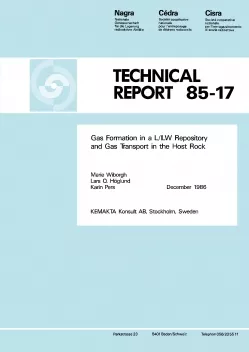
Technical Report NTB 85-17
Gas Formation in a L/ILW Repository and Gas Transport in the Host Rock
In a repository for low- and intermediate-level radioactive waste, gases will be formed due to corrosion, microbial degradation and radiolytic decomposition.
The predominant gas formation process is anaerobic corrosion of metals which yields over 90 % of all gases formed, based on a corrosion rate of 10-4 - 10-3 mm/year.
In this report, gas transport in the system of engineered barriers and gas transport in the host rock are treated separately.
The pressure build-up required to form cracks in the repository liner has been estimated and compared with the pressure required for gas transport in an unfractured barrier. The assumed range of permeabilities for the concrete barrier is 1 × 10-20 – 1 × 10-17 m2. The gas transport in the host rock is calculated for permeabilities of 1 × 10-19 – 1 × 10-15 m2.
The transport routes for the gases are the undisturbed host rock and the lineaments. The gas transport capacity in the host rock is sufficiently high to balance the rate of gas formation and has been found to be independent of the capacity in the lineaments when the permeability in the host rock is higher than 10-17 m2.
The gas transport capacities are calculated for a rock material with distributed fissure sizes. The relative permeability for the gas has been calculated using capillary pressure curves for three different rock materials – dolomite, sandstone and limestone. Additional calculations have been made for uniformly sized fissures.
